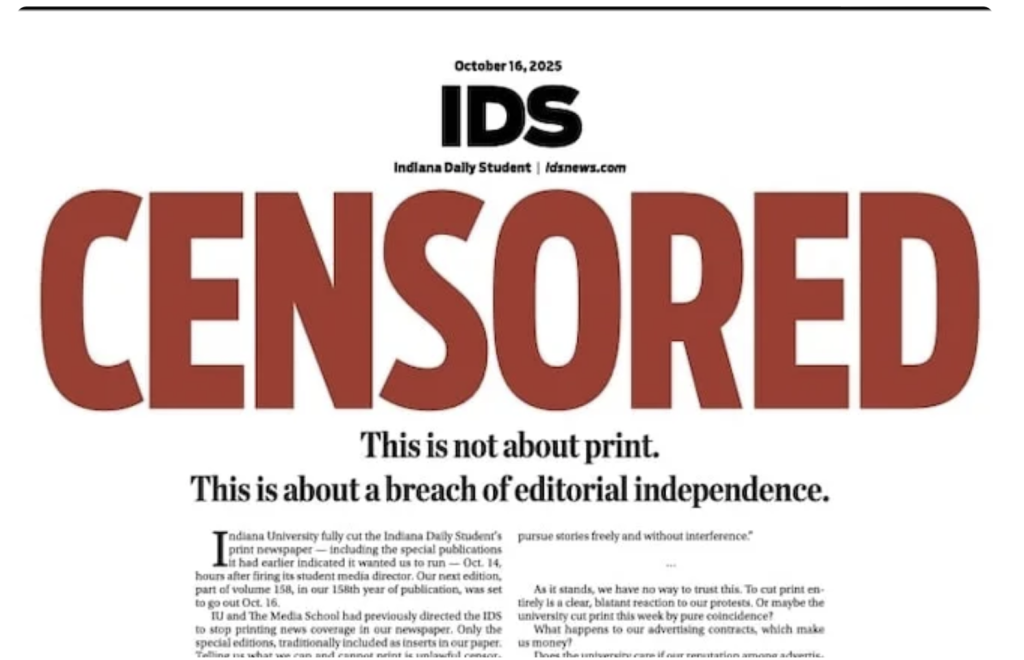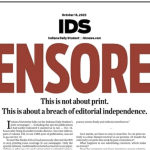About News
Don’t Mess With Student Journalism

People take up for college journalists faster than they will for the pros, so when a university administration decides to trample on campus media, it can get really embarrassing really fast for the administration.
As Indiana University just found out.
The university – shockingly including the dean of the Media School – fired the faculty adviser to IU’s student media for resisting a new university edict to limit the print editions of the Indiana Daily Student newspaper to special-event coverage, with no general news stories. In the midst of the newspaper’s pushback against the restriction, the university canceled print editions entirely.
IU’s censorship provoked a wave of unflattering national headlines. Some articles pointed out IU’s embarrassing ranking of 255th out of 257 universities for free speech, according to the advocacy group Foundation for Individual Rights in Education. Other stories pointed out the widespread unpopularity of IU’s president and the plagiarism allegations against her. Questions also arose about the journalism credentials of the Media School dean, whose background is in film (a swell insult to a lot of filmmakers in academia). One professional journalist wrote on a major trade website that she was now ashamed to be a graduate of the IU Media School. One big donor, billionaire Mark Cuban, criticized the university on his X account with nine million followers. On Monday, the Indianapolis Star published a story saying alumni have withdrawn more than $1 million in donations to the university because of the administration’s actions.
Hope it was worth all that, IU.
In written public statements, IU administrators claimed they aren’t dictating what the Indiana Daily Student can publish. Instead, they said, they are implementing a previously agreed upon plan to shift emphasis from print to digital platforms to address the IDS’ annual money deficit, which the university subsidizes, and to better reflect the future of journalism platforms. It’s impossible not to notice, however, that the IDS recently published some articles that reflected negatively on the university and planned another such story for what would have been the next print edition. And the school’s initial position was that print special sections with no traditional news stories were fine.
Scott Morris recognizes what’s happening at IU because it happened to him at the University of North Alabama in 2018. “The situation in Indiana struck me hard and stirred up a lot of negative emotions,” he wrote in an email.
In 2018, two weeks after the UNA student newspaper published a story that top administrators didn’t like, Morris effectively lost his job when the university rewrote the student media adviser job description to require a doctorate. Various national journalism advocacy groups publicly slammed UNA for retaliation against the exercise of press freedom. (For a more detailed account of the UNA case, read my blog post from February 2019 or Morris’ longer, better retelling on the BirminghamWatch website.)
Morris, a veteran journalist who is now retired, sees the IU situation as media suppression, not fiscal responsibility. “Administrators are too quick to use excuses centered on finances to impose censorship or to punish students and advisers for content,” he said. (For a different view, read this.)
College journalists are usually protected by the First Amendment, by grants of editorial independence in their organizational charters, and by most (but not all) court rulings on student press freedoms over the years. Sometimes, though, all of that gets ignored, as has happened at IU, Purdue, Ashland University and elsewhere. (I’m not aware of such an issue at UA.)
Morris believes censorship in college media is “a growing problem.” When it happens, he urges campus outlets to publicize their fight, ideally with additional publicity from professional media. “Use the press to call out administrators and to embarrass them by publishing their misdeeds and contrasting their misdeeds with the First Amendment. That is the greatest power that students possess, and often they don’t realize it.”
And one more idea: Eighteen states have passed “New Voices” legislation that addresses a U.S. Supreme Court loophole and protects high school and college journalists and their advisers. Indiana and Alabama are not among the 18. That number needs to become 50.

Tom Arenberg is an instructor of news media at the University of Alabama. He worked for The Birmingham News and the Alabama Media Group for 30 years. He published this commentary originally as a post on his blog, The Arenblog.
About News is a BirminghamWatch feature that publishes commentary by those who teach the craft and think about the values and performance of today’s journalism. BirminghamWatch also publishes About News articles on Facebook and invites readers to join the conversation there.


